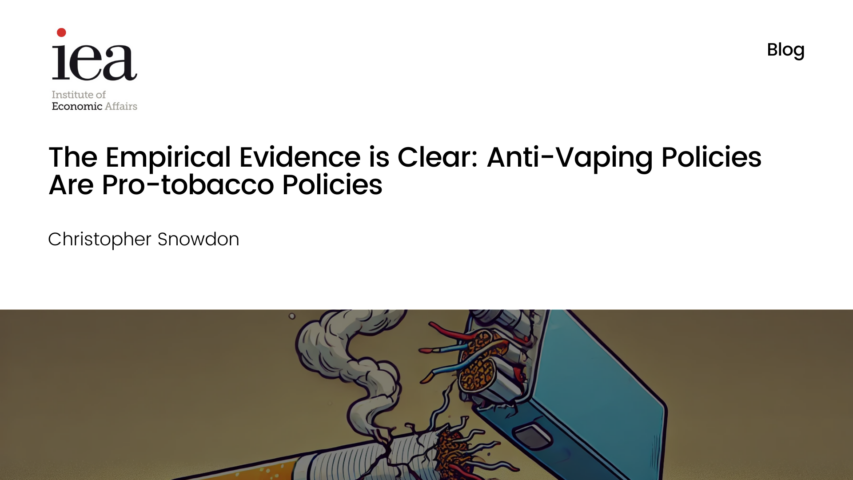The Empirical Evidence is Clear: Anti-Vaping Policies Are Pro-tobacco Policies

The Empirical Evidence is Clear: Anti-Vaping Policies Are Pro-tobacco Policies
Christopher Snowdon // 1 June 2021
A study published in JAMA Pediatrics this week looked a ban on e-cigarette flavours implemented in San Francisco on 1 January 2019. The ban was supposed to make e-cigarettes less appealing to young people. And so it did, but with the unintended consequence that high school students smoked more instead. After the ban came into effect, the youth of San Francisco were more than twice as likely to smoke than their counterparts in other districts. As the author noted: “This raises concerns that reducing access to flavored electronic nicotine delivery systems may motivate youths who would otherwise vape to substitute smoking.”
This finding did not come as a big surprise to anyone familiar with the academic literature. Cigarettes and e-cigarettes are clearly substitute products, as studies have shown in both the USA and the European Union. Last year, a study by Yang et al. found that the ban on e-cigarette flavours in San Francisco led to increased smoking prevalence among 18-24-year-olds. Cigarette sales in the USA overall rose in 2020, partly as a result of federal restrictions on flavours used in certain e-cigarette products.
The observation that e-cigarettes are a substitute for combustible cigarettes might seem obvious, but it has crucial implications for policy because it means that efforts to suppress e-cigarette use are likely to lead to greater use of traditional cigarettes.
The economics literature on e-cigarettes is relatively young, but taxes and regulations that make vaping less attractive to consumers have been repeatedly shown to increase cigarette consumption and smoking prevalence. Cotti et al. (2020) studied e-cigarette taxes in eight US states and found that a decline in e-cigarette pod sales led to an increase in the sale of traditional cigarettes. Pesko et al. (2020) found that “higher e-cigarette tax rates increase traditional cigarette use” and predicted that an e-cigarette tax of US$1.65 per ml would increase the number of daily smokers by one per cent. Saffer et al. (2019) concluded that a large tax on e-cigarettes in Minnesota prevented 32,400 smokers from quitting.
Abouk et al. (2019) found that e-cigarette taxes led to more women smoking in pregnancy. Friedman (2015) found that banning the sale of e-cigarettes to minors increased the underage smoking rate by 0.9 percentage points. Dave et al. (2019) found that a ban on e-cigarette advertising reduced the number of smokers who would have quit cigarettes by three per cent. Cox et al. (2018) found that EU warnings on e-cigarette products, which have been mandatory since 2016, made smokers less willing to purchase them.
When you have two substitute products, discouraging the use of one amounts to encouraging the use of the other. Anti-vaping policies are essentially pro-smoking policies.
The policy implications are obvious. Virtually every government in the world says it wants to reduce the smoking rate on health grounds and there is little doubt that e-cigarettes are at least 95 per cent safer than combustible cigarettes. Leaving aside the question of whether people’s smoking habits are any of the state’s business, it is plainly counterproductive to introduce policies that inadvertently promote smoking at the expense of a vastly safer substitute.
If lowering the smoking rate is your primary goal, you do not just tax vape juice at a lower rate than cigarettes. You do not tax it at all (in theory, you might even subsidise it). You do not give e-cigarettes a slightly more lenient regulatory framework than tobacco. You give them the optimum regulatory framework. And you certainly do not strip out one of the key features of e-cigarettes – flavours – that gives them a competitive advantage over combustible tobacco.
Last week, the European Commission published its preliminary thoughts on what to include in its forthcoming Tobacco Products Directive. One of the things it wants to “explore” is banning e-cigarette flavours. It describes its approach as “careful and precautionary”. It is not. It is risky and reckless.
The original article was published on the IEA’s blog.
EPICENTER publications and contributions from our member think tanks are designed to promote the discussion of economic issues and the role of markets in solving economic and social problems. As with all EPICENTER publications, the views expressed here are those of the author and not EPICENTER or its member think tanks (which have no corporate view).



